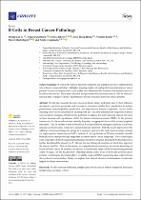B Cells in Breast Cancer Pathology
| dc.contributor | Vall d'Hebron Barcelona Hospital Campus |
| dc.contributor.author | Li, Mengyuan |
| dc.contributor.author | Quintana Vega, Angela |
| dc.contributor.author | Alberts, Ellie |
| dc.contributor.author | Hung, Miu Shing |
| dc.contributor.author | Boulat, Victoire |
| dc.contributor.author | Martí, Mercè |
| dc.contributor.author | Grigoriadis, Anita |
| dc.date.accessioned | 2023-04-25T06:39:38Z |
| dc.date.available | 2023-04-25T06:39:38Z |
| dc.date.issued | 2023-02-28 |
| dc.identifier.citation | Li M, Quintana A, Alberts E, Hung MS, Boulat V, Ripoll MM, et al. B Cells in Breast Cancer Pathology. Cancers. 2023 Feb 28;15(5):1517. |
| dc.identifier.issn | 2072-6694 |
| dc.identifier.uri | https://hdl.handle.net/11351/9408 |
| dc.description | Cèl·lules B; Càncer de mama; Ganglis limfàtics |
| dc.description.sponsorship | The authors acknowledge support by Breast Cancer Now (KCL-BCN-Q3), the Medical Research Council [MR/X012476/1]; Mengyuan Li was awarded funds by the China Scholarship Council [202008440233]; Elena Alberts was funded by the UK Medical Research Council Doctoral Training Programme; Victoire Boulat was awarded funds by Cancer Research UK (RE18831). |
| dc.language.iso | eng |
| dc.publisher | MDPI |
| dc.relation.ispartofseries | Cancers;15(5) |
| dc.rights | Attribution 4.0 International |
| dc.rights.uri | http://creativecommons.org/licenses/by/4.0/ |
| dc.source | Scientia |
| dc.subject | Mama - Càncer |
| dc.subject | Cèl·lules B |
| dc.subject.mesh | Breast Neoplasms |
| dc.subject.mesh | B-Lymphocytes |
| dc.title | B Cells in Breast Cancer Pathology |
| dc.type | info:eu-repo/semantics/article |
| dc.identifier.doi | 10.3390/cancers15051517 |
| dc.subject.decs | neoplasias de la mama |
| dc.subject.decs | linfocitos B |
| dc.relation.publishversion | https://doi.org/10.3390/cancers15051517 |
| dc.type.version | info:eu-repo/semantics/publishedVersion |
| dc.audience | Professionals |
| dc.contributor.organismes | Institut Català de la Salut |
| dc.contributor.authoraffiliation | [Li M, Hung MS] Cancer Bioinformatics, School of Cancer & Pharmaceutical Sciences, Faculty of Life Sciences and Medicine, King’s College London, London, UK. School of Cancer & Pharmaceutical Sciences, Faculty of Life Sciences and Medicine, King’s College London, London, UK. [Quintana A] Vall d’Hebron Institute of Oncology (VHIO), Barcelona, Spain. [Alberts E, Boulat V] Cancer Bioinformatics, School of Cancer & Pharmaceutical Sciences, Faculty of Life Sciences and Medicine, King’s College London, London, UK. School of Cancer & Pharmaceutical Sciences, Faculty of Life Sciences and Medicine, King’s College London, London, UK. Immunity and Cancer Laboratory, The Francis Crick Institute, London, UK. [Martí Ripoll M] Immunology Unit, Department of Cell Biology, Physiology and Immunology, Universitat Autònoma de Barcelona, Barcelona, Spain. Biosensing and Bioanalysis Group, Institute of Biotechnology and Biomedicine, Universitat Autònoma de Barcelona, Barcelona, Spain. [Grigoriadis A] Cancer Bioinformatics, School of Cancer & Pharmaceutical Sciences, Faculty of Life Sciences and Medicine, King’s College London, London, UK. School of Cancer & Pharmaceutical Sciences, Faculty of Life Sciences and Medicine, King’s College London, London, UK. Breast Cancer Now Unit, School of Cancer & Pharmaceutical Sciences, Faculty of Life Sciences and Medicine, King’s College London, London, UK |
| dc.identifier.pmid | 36900307 |
| dc.identifier.wos | 000947371500001 |
| dc.rights.accessrights | info:eu-repo/semantics/openAccess |
Fitxers en aquest element
Aquest element apareix en la col·lecció o col·leccions següent(s)
-
VHIO - Articles científics [1250]

 Àrea privada
Àrea privada Contacte
Contacte








